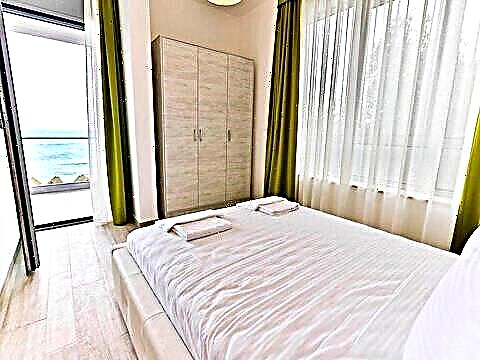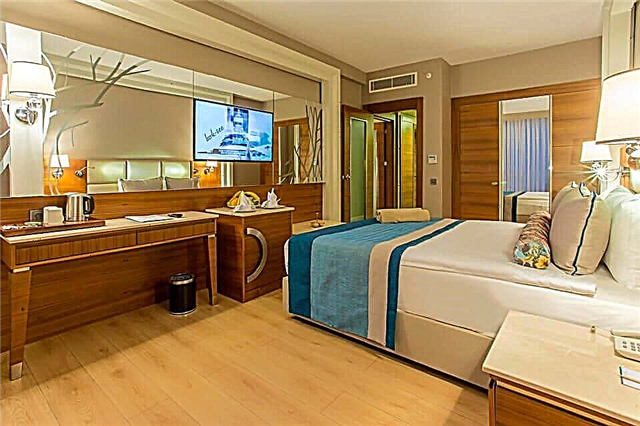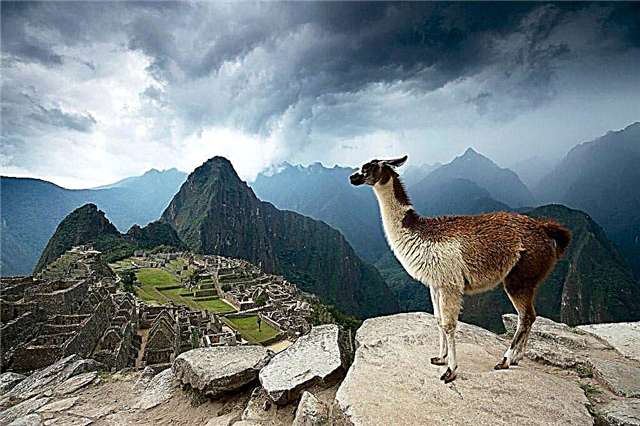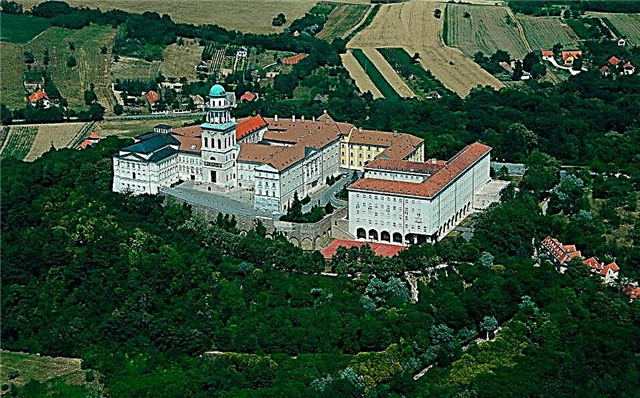Address: Russia, St. Petersburg, Peterhof
Area: 15 hectares
Main attractions: Oak fountain, Square Ponds fountains, Neptune fountain, Mezheumny fountain
Coordinates: 59 ° 52'58.6 "N 29 ° 54'28.2" E
Content:
The regular part of the Peterhof Park attracts tourists in any season. In the spring, the Upper Garden pleases with petals of flowering apple trees, snowdrops and blossoming buds, in summer - with lush flowers in flower beds and green lawns, in autumn - with the bright color of fading foliage, and in winter - with white lace and clean frosty air. Residents of St. Petersburg and guests of the city enjoy walking along the straight alleys and admiring the spray of fountains.

General view of the Upper Garden of Peterhof
How the new park was laid
In 1716, Peter I went on a tour of Western Europe. During a visit to France, he visited the Botanical Gardens of Paris and the famous palace and park ensembles that belonged to the French kings. Peter I saw how to equip a country estate and turn it into a real paradise on earth. He really liked the idea of well-kept gardens and graceful park pavilions, original landscape solutions and the arrangement of fountains.
The Russian emperor was distinguished by curiosity and healthy practicality. When Peter I began to build his own residence near St. Petersburg, he wanted a useful garden and vegetable garden around the palace buildings.

The main gate to the Upper Garden of Peterhof
From France, the famous architect Jean-Baptiste Leblond came to the service of the Russian Tsar, and he was assigned to lead all the work on the construction of Peterhof. Considering the scale of the territory, the talented master coped with the task brilliantly. Already in 1725, the royal residence received its first guests.
The upper garden was laid out on a wide terrace to the south of the Grand Palace. It played the role of a ceremonial lobby at the entrance to the main building of Peterhof. The Tsar wanted the spacious and bright park to look harmonious and resemble a large green lobby. The layout of the paths and reservoirs was made according to the sketches of Peter I himself, the territory has changed little over the years.

Fountain Mezheumny in the Upper Garden of Peterhof
The planting of trees and shrubs was supervised by a gardener from Holland - Leonard von Garnichfelt. He was engaged in the breakdown of intricate flower beds and curly haircut of green spaces. In 1723, Garnichfelt created the first garden school in our country in the new Russian capital, where he began to teach young gardeners the secrets of his craft.
Under Peter I, in front of the palace, one could see beds with vegetables and potato tubers, which are outlandish for Russia. Herbs and medicinal plants, berries and fruits were grown here. Different types of fish were bred in the ponds, which were prepared by the tsar's chefs and served to the table.

Fountain Neptune in the Upper Garden of Peterhof
Arrangement of the park in the XVIII-XX centuries
During the reign of the daughter of Peter I, Elizabeth Petrovna, the fashion for regular French parks came to Russia, so it was decided to give the Peterhof plantations a ceremonial look. The garden beds and outbuildings were removed from the garden near the palace. Light trellis pavilions and gilded sculptures appeared in the parterre, and fountains were arranged in the Square pools, which in those days were called "water extravaganzas".
The Upper Garden acquired its present appearance in the second half of the 18th century, when the architect Bartolomeo Francesco Rastrelli supervised the reconstruction of the Grand Palace. The genius master of Elizabethan baroque served as chief architect under the queen and was the author of the most ambitious urban planning projects of that era.

Eastern fountain of Square Ponds in the Upper Garden of Peterhof against the background of the Church of Peter and Paul
Rastrelli strove to make the Upper Garden match the solemn appearance of the imperial palace. According to his project, the green area was expanded. A fence of stone pillars with wooden trellises was erected around the garden, and a massive gate with wrought iron doors appeared at the front entrance from the road. Now the travelers who came to Peterhof by land had no doubts that they were facing the luxurious residence of the Russian monarch.
At the beginning of the 19th century, the fashion for French trends passed, so gardeners stopped worrying about straight paths, lawn symmetry, cutting trees and shrubs. The appearance of the Upper Garden was gradually changing, and it became like a picturesque landscape park.

Gallery-bersot in the Upper Garden of Peterhof
What a garden looks like today
Today the famous garden has an area of 15 hectares. The central part is occupied by a spacious parterre and green lawns. To the left and to the right of it are two large ponds and six bosquets, which are framed by neat trimmed bushes. The straight layout of the French park is emphasized by smooth linden alleys, symmetrical forms of well-groomed lawns, openwork bersot galleries and dark green thuja, whose crowns are decorated in the form of geometric shapes.
Since the 1730s, the park has Square Ponds near the palace and three stone pools that are on its main axis. Artificial reservoirs of the Upper Garden play not only a decorative role. They accumulate water, which then flows through pipes to the fountain complexes of the Lower Park.

Flora statue in the Upper Garden of Peterhof
In the bosquets near the western pond, you can see a pharmacy garden and fruit trees. The gardeners of Peterhof made a lot of efforts to revive the beds with medicinal plants, which the garden was famous for in the times of Peter the Great. Today, like three hundred years ago, St. John's wort, lemon balm, mint, oregano, echinacea and other medicinal herbs grow in front of the palace. Rectangular beds with bright yellow sunflowers look very nice.
A rose garden is laid out next to the Square Pond on the east side. Sprawling rose bushes are not fenced in by anything. Tourists are happy to sit on park benches and enjoy the enchanting scent of different types of roses.

In the northeastern corner of the garden rises the church building of the Grand Palace. The court church was built in 1745 by B.F.Rastrelli. In 2011, the splendid Baroque temple was restored and became part of the museum-reserve. Inside you can see collections of old icons, church utensils, priests' vestments and rare baptismal sets.
Sculptures
One of the main decorations of the garden is graceful park sculptures. The design of the fountains of the Square Ponds stands out noticeably. Figures of Venus and Apollo are installed in the middle of the mirror ponds. The twin sculptures are surrounded by six gilded bronze dolphins, and streams of water burst from the open mouths of sea animals.

The middle of the three fountains is decorated with a three-tiered pedestal on which Neptune rises. The foot of the god of the seas is surrounded by outlandish newts, seahorses, dragons, dolphins, male riders and two female figures - the German rivers Regnitz and Pegnitz. The sculptural group is dedicated to the victory of the city of Nuremberg over the Swedish troops.
The pool next to the palace is decorated with a tuff starfish. A white marble statue of Cupid with a theatrical mask flaunts on the stones. This design of the fountain appeared in the 1920s, and the name "Oak" remained from the 18th century, when a lead tree stood in the middle of the reservoir.

The fountain "Mezheumny" farthest from the palace, that is, "undefined", is decorated with figures of dolphins and a gilded dragon. In the parterre, you can see several expressive marble statues - the god of the warm wind Zephyr, the ruler of spring Flora, the owner of gardens and seasons Vertumnus and the heavenly patroness of fertility Pomona. These are copies of works by the famous 18th century Italian master Antonio Bonazza.
Useful information for tourists
The territory of the garden is fenced. The entrance is open any day from 9:00 to 21:30, and in winter until 18:00.You can admire the beautiful fountains during the warm season from 10:00 to 18:00.

Excursion service is provided for groups of up to 30 people. A walk along the green alleys with a guide costs 1000 rubles.
How to get there
The territory of the Upper Garden is located 40 km from the northern capital, between the Bolshoi Peterhof Palace and St. Petersburg Avenue. Several minibuses and buses run from the Avtovo metro station to the site. The journey takes 40 minutes. The Fontany stop is located right in front of the entrance to the Upper Garden.

You can get from the city to the park by taxi or by river - by meteor. Another option is to get to Peterhof by electric trains that run from the Baltic Station. From the railway station "New Peterhof" to the park you need to walk 3 km.











